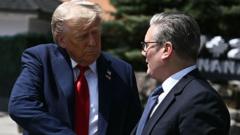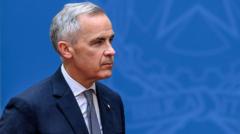Canadians are heading to the polls in a significant electoral moment, choosing their next leader against the backdrop of President Trump's ongoing trade war which has dramatically shifted political dynamics in the country.
Canada Faces Pivotal Election Amid Trumpian Turmoil

Canada Faces Pivotal Election Amid Trumpian Turmoil
Canadians are casting ballots in a crucial election that may shape the nation's response to U.S. pressures and economic uncertainties.
April 28, 2025, 5:03 PM ET
Canadians are participating in a pivotal election today that holds significant implications for the nation’s future. Voters will determine who leads the country, particularly in navigating the challenges posed by President Trump’s aggressive tariffs and sovereignty threats, which have reshaped the political landscape dramatically.
Initially, the Conservative Party, led by Pierre Poilievre, seemed poised for victory. However, the resignation of former Prime Minister Justin Trudeau and the emergence of Mark Carney as the Liberal Party leader following Trudeau's departure have resulted in a notable shift in voter sentiment. Opinion polls now indicate a competitive race between the Liberals, under Carney, who brings extensive financial expertise, and the Conservatives, whose ideological alignment with Trump may be alienating some voters.
The election features three additional parties: the New Democratic Party (NDP), the Greens, and the Bloc Québécois, focusing on Quebec sovereignty. The latter has experienced a steep decline in support as many Quebec voters reconsider aligning with it amid fears surrounding Canadian sovereignty.
Polling stations began opening across Canada, with staggered closing times to accommodate the nation's six time zones. The outcome is anticipated late this evening, as traditional hand-counting of ballots will determine the new Parliament, comprising 343 seats.
Mark Carney, a seasoned central banker, has aimed his campaign at portraying himself as a bulwark against Trump’s aggressive stance, appealing significantly to voters weary of instability. Meanwhile, Pierre Poilievre’s populism aligns closely with Trump’s narrative, focusing on reduced regulation and cutting foreign aid—a position that contrasts sharply with Carney’s centrist approach.
In regions like French-speaking Quebec, the Liberals are climbing in the polls after an initial surge by the Bloc Québécois. Concerns over Trump’s economic policies are leading voters to favor candidates perceived as capable of effectively managing these pressures. Carney’s financial acumen is being touted as an asset amid current economic uncertainties, with many Canadians seeking stability amid rising living costs, particularly in housing, groceries, and gas prices.
The election’s tenor contrasts sharply to the political climate just months prior, where Conservatives enjoyed a substantial lead. The unpredictability of Trump's policies, characterized by tariffs and aggressive rhetoric about annexation, has seemingly reversed the tides for traditional Conservative strongholds.
With critical issues including economic resilience and national sovereignty at play, the results of today’s election will not only shape Canada’s immediate political landscape but also define its long-term relationship with its powerful neighbor to the south. Observers await the final counts, fully aware that the implications of this election extend far beyond just Canada’s borders.
Canadians are participating in a pivotal election today that holds significant implications for the nation’s future. Voters will determine who leads the country, particularly in navigating the challenges posed by President Trump’s aggressive tariffs and sovereignty threats, which have reshaped the political landscape dramatically.
Initially, the Conservative Party, led by Pierre Poilievre, seemed poised for victory. However, the resignation of former Prime Minister Justin Trudeau and the emergence of Mark Carney as the Liberal Party leader following Trudeau's departure have resulted in a notable shift in voter sentiment. Opinion polls now indicate a competitive race between the Liberals, under Carney, who brings extensive financial expertise, and the Conservatives, whose ideological alignment with Trump may be alienating some voters.
The election features three additional parties: the New Democratic Party (NDP), the Greens, and the Bloc Québécois, focusing on Quebec sovereignty. The latter has experienced a steep decline in support as many Quebec voters reconsider aligning with it amid fears surrounding Canadian sovereignty.
Polling stations began opening across Canada, with staggered closing times to accommodate the nation's six time zones. The outcome is anticipated late this evening, as traditional hand-counting of ballots will determine the new Parliament, comprising 343 seats.
Mark Carney, a seasoned central banker, has aimed his campaign at portraying himself as a bulwark against Trump’s aggressive stance, appealing significantly to voters weary of instability. Meanwhile, Pierre Poilievre’s populism aligns closely with Trump’s narrative, focusing on reduced regulation and cutting foreign aid—a position that contrasts sharply with Carney’s centrist approach.
In regions like French-speaking Quebec, the Liberals are climbing in the polls after an initial surge by the Bloc Québécois. Concerns over Trump’s economic policies are leading voters to favor candidates perceived as capable of effectively managing these pressures. Carney’s financial acumen is being touted as an asset amid current economic uncertainties, with many Canadians seeking stability amid rising living costs, particularly in housing, groceries, and gas prices.
The election’s tenor contrasts sharply to the political climate just months prior, where Conservatives enjoyed a substantial lead. The unpredictability of Trump's policies, characterized by tariffs and aggressive rhetoric about annexation, has seemingly reversed the tides for traditional Conservative strongholds.
With critical issues including economic resilience and national sovereignty at play, the results of today’s election will not only shape Canada’s immediate political landscape but also define its long-term relationship with its powerful neighbor to the south. Observers await the final counts, fully aware that the implications of this election extend far beyond just Canada’s borders.






















